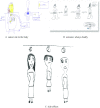The impact of social inequalities on children's knowledge and representation of health and cancer
- PMID: 29808238
- PMCID: PMC6061049
- DOI: 10.1007/s00431-018-3173-3
The impact of social inequalities on children's knowledge and representation of health and cancer
Abstract
Reducing inequalities in the field of cancer involves studying the knowledge and mental representations of cancer among children. A qualitative study was conducted on 191 children aged 9 to 12 using the "write and draw" technique to get spontaneous mental representations of "healthy things", "unhealthy things" and "cancer". We grouped the voluntary schools according to two deprivation levels. In response to the request to "write or draw anything you think keeps you healthy", the main responses categories were physical activity, healthy food and basic needs. Smoking, drinking alcohol, sedentary lifestyles/lack of sport were identified as "unhealthy". The first theme associated with "cancer" is the "cancer site" implying children have a segmented perception of cancer. Deprived children have radically different views about the key items representing cancer: they are more likely to believe the illness is systematically deadly. They are less likely to believe it is a treatable illness. They are less likely to associate cancer with risky behaviors, particularly alcohol consumption.
Conclusion: Social inequalities affect representations of cancer and health literacy from early childhood. Prevention programs taking into account these representations need to be introduced at school. What is Known: • Social inequalities for cancer mortality are observed in all European countries and are particularly pronounced in France. • Reducing these inequalities in prevention programs implies studying the knowledge and mental representations of cancer among children. What is New: • This study identified representations of cancer in young children according to social level. • At age 9, children living in deprived areas are less able to produce content in discussions about cancer and have narrower mental representations and a more fatalistic view.
Keywords: Cancer; Developmental/behavioral issues; Health inequalities; Prevention; School health.
Conflict of interest statement
Ethical approval
All procedures performed in this study were in accordance with ethical standards. The study has been declared with the French National Commission on Information Technology and Liberties (CNIL No. 1688834v0). The relevant ethics committee (CHU–St Etienne) has delivered its favorable opinion on the investigation plan (IRBN 602015/CHUSTE).
Conflict of interest
Véronique Régnier Denois declares that she has no conflict of interest. Aurelie Bourmaud received non-financial support and research travel cover from Abbie Pharmaceuticals. Mabrouk Nekaa declares that he has no conflict of interest. Céline Bezzaz declares that she has no conflict of interest. Véronique Bousser declares that she has no conflict of interest. Julie Kalecinski declares that she has no conflict of interest. Julia Dumesnil declares that she has no conflict of interest. Fabien Tinquaut declares that he has no conflict of interest. Dominique Berger declares that he has no conflict of interest. Franck Chauvin declares that he has no conflict of interest. All authors declare that they have no conflict of interest or financial relationship with the organization that sponsored the research.
Informed consent
In accordance with ethical approval requirements, individual informed consent was not required for the children. An agreement has been signed with the National Education administration. Information about the study was given to the participating school inspector and school leaders, as well as to the teaching team, parents and children involved.
Figures
References
MeSH terms
LinkOut - more resources
Full Text Sources
Other Literature Sources
Medical


